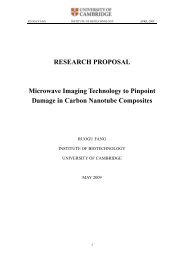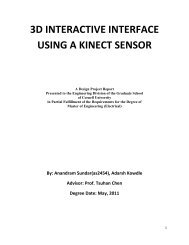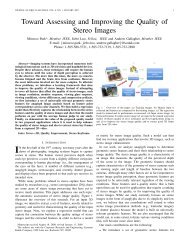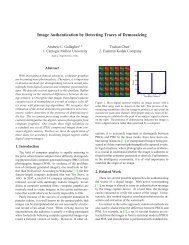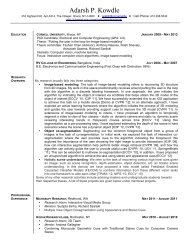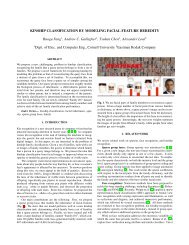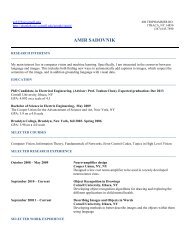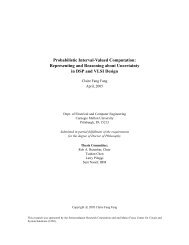iCoseg: Interactive Co-segmentation with Intelligent Scribble Guidance
iCoseg: Interactive Co-segmentation with Intelligent Scribble Guidance
iCoseg: Interactive Co-segmentation with Intelligent Scribble Guidance
You also want an ePaper? Increase the reach of your titles
YUMPU automatically turns print PDFs into web optimized ePapers that Google loves.
and request label for the data-point <strong>with</strong> maximal disagreement<br />
among classifier outcomes. We use this intuition to<br />
define our next cue. For each superpixel, we use our learnt<br />
distances (recall: these are used to define the edge smoothness<br />
terms in our energy function) to find K (=10) nearest<br />
neighbours from the labelled superpixels. We treat the proportion<br />
of each class in the returned list as the probability of<br />
assigning that class to this site, and use the entropy of this<br />
distribution as our cue. The intuition behind this cue is that<br />
the more uniform this distribution, the more disagreement<br />
there is among the the returned neighbour labels, and the<br />
more we would like to observe the label of this site.<br />
Graph-cut Uncertainty (GC). This cue tries to capture<br />
the confidence in the energy minimizing state returned by<br />
graph-cuts. For each site, we compute the increase in energy<br />
by flipping the optimal assignment at that site. The<br />
intuition behind this cue is that the smaller the energy difference<br />
by flipping the optimal assignment at a site, the<br />
more uncertain the system is of its label. We note that minmarginals<br />
proposed by Kohli et al. [16] could also be used.<br />
4.2. <strong>Scribble</strong>-based Cues<br />
Distance Transform over <strong>Scribble</strong>s (DT). For this cue, we<br />
compute the distance of every pixel to the nearest scribble<br />
location. The intuition behind this (weak) cue is that we<br />
would like to explore regions in the image away from the<br />
current scribble because they hold potentially different features<br />
than sites closer to the current scribbles.<br />
Intervening <strong>Co</strong>ntours over <strong>Scribble</strong>s (IC). This cue uses<br />
the idea of intervening contours [18]. The value of this cue<br />
at each pixel is the maximum edge magnitude in the straight<br />
line to the closest scribble. This results in low confusions<br />
as we move away from a scribble until a strong edge is observed,<br />
and then higher confusions on the other side of the<br />
edge. The motivation behind this cue is that edges in images<br />
typically denote contrast change, and by observing scribble<br />
labels on both sides of an edge, we can learn whether or not<br />
to respect such edges for future <strong>segmentation</strong>s.<br />
4.3. Image-level Cues<br />
The cues described so far, are local cues, that describe<br />
which region in an image should be scribbled on next. In<br />
addition to these, we also use some image-level cues (i.e.,<br />
uniform over an image), that help predict which image to<br />
scribble next, not where.<br />
Segment size (SS). We observe that when very few scribbles<br />
are marked, energy minimization methods typically<br />
over-smooth and results in “whitewash” <strong>segmentation</strong>s (entire<br />
image labelled as foreground or background). This cue<br />
incorporates a prior for balanced <strong>segmentation</strong>s by assigning<br />
higher confusion scores to images <strong>with</strong> more skewed<br />
<strong>segmentation</strong>s. We normalize the size of foreground and<br />
background regions to get class distributions for this image,<br />
(a) Image+<strong>Scribble</strong>s (b) Node Uncertainty (c) Edge Uncertainty<br />
(d) GC Uncertainty (e) Distance Transform (f) Intervening <strong>Co</strong>ntour<br />
(g) <strong>Co</strong>mbining cues<br />
Figure 3: Cues: (a) shows the image <strong>with</strong> provided scribbles; (b)-<br />
(f) show various cues; and (g) shows how these cues are combined<br />
to produce a final recommendation map.<br />
and use the inverse of the entropy of this distribution as our<br />
cue.<br />
<strong>Co</strong>deword Distribution over Images (CD). This imagelevel<br />
cue captures how diverse an image is, <strong>with</strong> the<br />
motivation being that scribbling on images containing<br />
more diversity among features would lead to better foreground/background<br />
models. To compute this cue, we cluster<br />
the features computed from all superpixels in the group<br />
to form a codebook, and the confusion score for each image<br />
is the entropy of the distribution over the codewords observed<br />
in the image. The intuition is that the more uniform<br />
the codeword distribution for an image the more diverse the<br />
appearances of different regions in the image.<br />
4.4. <strong>Co</strong>mbined Recommendation Map<br />
We now describe how we combine these various cues<br />
to produce a combined confusion map. Intuitively, the optimal<br />
combination scheme would be one that generates a<br />
recommendation map that assigns high values to regions<br />
that a user would scribble on, if they were to exhaustively<br />
examine all <strong>segmentation</strong>s. Users typically scribble on regions<br />
that are incorrectly segmented. We cast the problem<br />
of learning the optimal set of weights for our cues, as that of<br />
learning a linear classifier (logistic regression) that maps every<br />
superpixel (represented by a 7-dimensional feature vector<br />
corresponding to each of the 7 cues described above) to<br />
the (binary) <strong>segmentation</strong> error-map. Our cue combination



